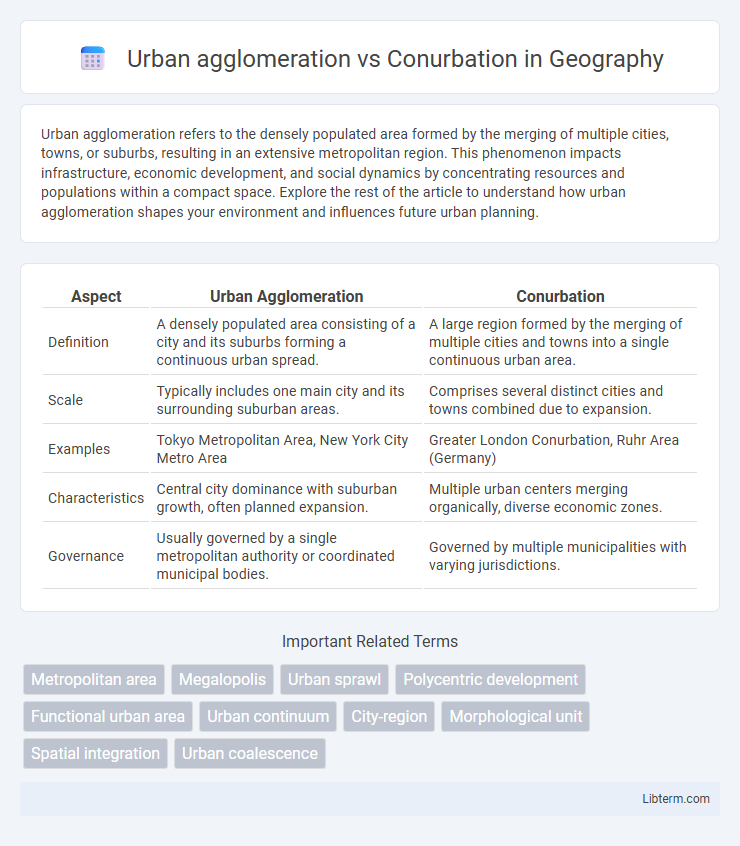Urban agglomeration refers to the densely populated area formed by the merging of multiple cities, towns, or suburbs, resulting in an extensive metropolitan region. This phenomenon impacts infrastructure, economic development, and social dynamics by concentrating resources and populations within a compact space. Explore the rest of the article to understand how urban agglomeration shapes your environment and influences future urban planning.
Table of Comparison
| Aspect | Urban Agglomeration | Conurbation |
|---|---|---|
| Definition | A densely populated area consisting of a city and its suburbs forming a continuous urban spread. | A large region formed by the merging of multiple cities and towns into a single continuous urban area. |
| Scale | Typically includes one main city and its surrounding suburban areas. | Comprises several distinct cities and towns combined due to expansion. |
| Examples | Tokyo Metropolitan Area, New York City Metro Area | Greater London Conurbation, Ruhr Area (Germany) |
| Characteristics | Central city dominance with suburban growth, often planned expansion. | Multiple urban centers merging organically, diverse economic zones. |
| Governance | Usually governed by a single metropolitan authority or coordinated municipal bodies. | Governed by multiple municipalities with varying jurisdictions. |
Introduction to Urban Agglomeration and Conurbation
Urban agglomeration refers to an extended city or town area comprising the built-up area and any suburbs linked economically and socially. Conurbation describes a large urban area formed by the merging of multiple cities, towns, or urban centers, creating a continuous metropolitan region. Both concepts highlight patterns of urban expansion, but urban agglomerations emphasize a single core city's growth, while conurbations focus on the fusion of distinct urban units.
Defining Urban Agglomeration
Urban agglomeration refers to the extended city or town area comprising the built-up area and any suburbs or continuous areas linked economically and socially, forming a single urban entity. It emphasizes the population concentration within connected urban growth, reflecting demographic and infrastructural integration rather than administrative boundaries. Unlike conurbation, which involves the merging of distinct metropolitan areas, urban agglomeration focuses on a unified urban spread predominantly centered around a core city.
What is a Conurbation?
A conurbation is a large urban area formed by the continuous merging of multiple cities, towns, and suburbs into a single, extensive metropolitan region. Unlike urban agglomerations, which can include a dominant central city surrounded by smaller satellite towns, conurbations consist of several significant urban centers that have grown together through spatial expansion. This phenomenon often results in complex administrative challenges and interconnected economic activities across the merged urban entities.
Key Differences between Urban Agglomeration and Conurbation
Urban agglomeration refers to a densely populated area consisting of a central city and its surrounding suburbs or towns, forming a continuous urban region without necessarily merging multiple cities. In contrast, conurbation describes the extensive urban area created when two or more neighboring cities or large towns grow and physically merge due to population expansion and urban sprawl. Key differences include the scale and composition, where urban agglomeration is typically centered around a single core city, while conurbation involves a network of multiple interconnected urban centers.
Historical Development Patterns
Urban agglomeration historically emerged from the expansion of a single city absorbing surrounding towns and villages, driven by population growth and economic integration. Conurbation developed later as multiple adjacent cities and towns merged into a continuous metropolitan region due to industrialization and improved transportation networks. The historical development patterns of urban agglomerations often reflect centralized urban growth, while conurbations represent polycentric expansion shaped by regional planning and infrastructure connectivity.
Examples of Global Urban Agglomerations
Global urban agglomerations, such as Tokyo, New York, and Shanghai, represent extensive metropolitan areas encompassing multiple cities and towns with a high density of population and interconnected infrastructure. Unlike conurbations, which specifically describe merged urban areas formed by the physical expansion of neighboring cities such as the Ruhr in Germany or the Dallas-Fort Worth metroplex in the USA, urban agglomerations include broader socio-economic and functional linkages beyond mere geographical continuity. These agglomerations are critical in analyzing global urbanization patterns, economic hubs, and regional planning strategies.
Notable Conurbations around the World
Notable conurbations such as the Greater Tokyo Area, the largest urban agglomeration globally, exemplify extensive interconnected metropolitan regions formed by merging multiple cities. The Randstad in the Netherlands and the Ruhr area in Germany both highlight European conurbations characterized by dense population and industrial integration. In the United States, the Northeast megalopolis stretching from Boston to Washington, D.C., illustrates a significant conurbation shaped by continuous urban sprawl and economic interdependence.
Socioeconomic Impacts
Urban agglomeration concentrates economic activities, leading to increased job opportunities, higher productivity, and diversified markets, which stimulate regional economic growth. Conurbation intensifies socioeconomic interactions across merged cities, fostering innovation, infrastructure development, and social integration but can also exacerbate urban challenges like congestion and inequality. Both phenomena reshape demographic patterns, influence housing demand, and impact public services, requiring strategic urban planning to balance growth and social welfare.
Urban Planning Challenges and Solutions
Urban agglomerations often face challenges related to infrastructure overload, transportation inefficiencies, and unplanned spatial growth, requiring integrated land-use policies and enhanced public transit systems to improve connectivity and reduce congestion. Conurbations, characterized by the merging of multiple cities, demand coordinated governance frameworks to manage shared resources, harmonize zoning regulations, and address environmental sustainability across jurisdictional boundaries. Implementing smart city technologies and participatory urban planning can optimize resource allocation and foster sustainable development in both urban agglomerations and conurbations.
Future Trends in Urban Growth
Future trends in urban growth indicate that urban agglomerations will expand through increased population density and vertical development, driven by smart city technologies and sustainable infrastructure. Conurbations, characterized by the merging of multiple cities, will see growth fueled by regional collaboration and improved transportation networks enhancing connectivity. Both forms of urbanization will emphasize eco-friendly solutions to address challenges such as congestion, pollution, and resource management in rapidly urbanizing regions.
Urban agglomeration Infographic

 libterm.com
libterm.com